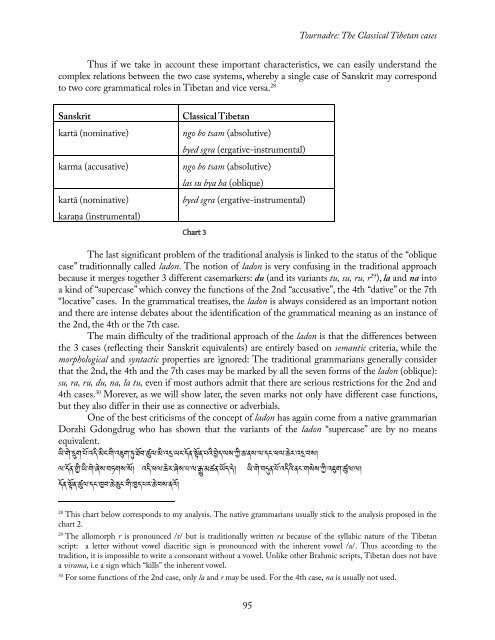The Classical Tibetan cases and their transcategoriality
The Classical Tibetan cases and their transcategoriality
The Classical Tibetan cases and their transcategoriality
Create successful ePaper yourself
Turn your PDF publications into a flip-book with our unique Google optimized e-Paper software.
95<br />
Tournadre: <strong>The</strong> <strong>Classical</strong> <strong>Tibetan</strong> <strong>cases</strong><br />
Thus if we take in account these important characteristics, we can easily underst<strong>and</strong> the<br />
complex relations between the two case systems, whereby a single case of Sanskrit may correspond<br />
to two core grammatical roles in <strong>Tibetan</strong> <strong>and</strong> vice versa. 28<br />
Sanskrit <strong>Classical</strong> <strong>Tibetan</strong><br />
kartā (nominative) ngo bo tsam (absolutive)<br />
byed sgra (ergative-instrumental)<br />
karma (accusative) ngo bo tsam (absolutive)<br />
las su bya ba (oblique)<br />
kartā (nominative)<br />
karaṇa (instrumental)<br />
byed sgra (ergative-instrumental)<br />
Chart 3<br />
<strong>The</strong> last significant problem of the traditional analysis is linked to the status of the “oblique<br />
case” traditionnally called ladon. <strong>The</strong> notion of ladon is very confusing in the traditional approach<br />
because it merges together 3 different casemarkers: du (<strong>and</strong> its variants tu, su, ru, r29 ), la <strong>and</strong> na into<br />
a kind of “supercase” which convey the functions of the 2nd “accusative”, the 4th “dative” or the 7th<br />
“locative” <strong>cases</strong>. In the grammatical treatises, the ladon is always considered as an important notion<br />
<strong>and</strong> there are intense debates about the identification of the grammatical meaning as an instance of<br />
the 2nd, the 4th or the 7th case.<br />
<strong>The</strong> main difficulty of the traditional approach of the ladon is that the differences between<br />
the 3 <strong>cases</strong> (reflecting <strong>their</strong> Sanskrit equivalents) are entirely based on semantic criteria, while the<br />
morphological <strong>and</strong> syntactic properties are ignored: <strong>The</strong> traditional grammarians generally consider<br />
that the 2nd, the 4th <strong>and</strong> the 7th <strong>cases</strong> may be marked by all the seven forms of the ladon (oblique):<br />
su, ra, ru, du, na, la tu, even if most authors admit that there are serious restrictions for the 2nd <strong>and</strong><br />
4th <strong>cases</strong>. 30 Morever, as we will show later, the seven marks not only have different case functions,<br />
but they also differ in <strong>their</strong> use as connective or adverbials.<br />
One of the best criticisms of the concept of ladon has again come from a native grammarian<br />
Dorzhi Gdongdrug who has shown that the variants of the ladon “supercase” are by no means<br />
equivalent.<br />
ཡི་གེ་དྲུག་པོ་འདི་མིང་གི་འཇུག་ཏུ་ཐོབ་ཚུལ་མི་འདྲ་ཡང་དོན་སྟོན་པའི་བྱེད་ལས་ཀྱི་ཆ་ནས་ལ་དང་ཕལ་ཆེར་འདྲ་བས།<br />
ལ་དོན་གྱི་ཡི་གེ་ཞེས་བཏགས་སོ། འདི་ཕལ་ཆེར་ཞེས་པ་ལ་རྒྱུ་མཚན་ཡོད་དེ། ཡི་གེ་བདུན་པོ་འདིའི་ནང་གསེས་ཀྱི་འཇུག་ཚུལ་ལ།<br />
དོན་སྟོན་ཚུལ་དང་ཁྱབ་ཆེ་ཆུང་གི་ཁྱད་པར་ཆེ་བས་ནའོ།<br />
28 This chart below corresponds to my analysis. <strong>The</strong> native grammarians usually stick to the analysis proposed in the<br />
chart 2.<br />
29 <strong>The</strong> allomorph r is pronounced /r/ but is traditionally written ra because of the syllabic nature of the <strong>Tibetan</strong><br />
script: a letter without vowel diacritic sign is pronounced with the inherent vowel /a/. Thus according to the<br />
tradition, it is impossible to write a consonant without a vowel. Unlike other Brahmic scripts, <strong>Tibetan</strong> does not have<br />
a virama, i.e a sign which “kills” the inherent vowel.<br />
30 For some functions of the 2nd case, only la <strong>and</strong> r may be used. For the 4th case, na is usually not used.
















